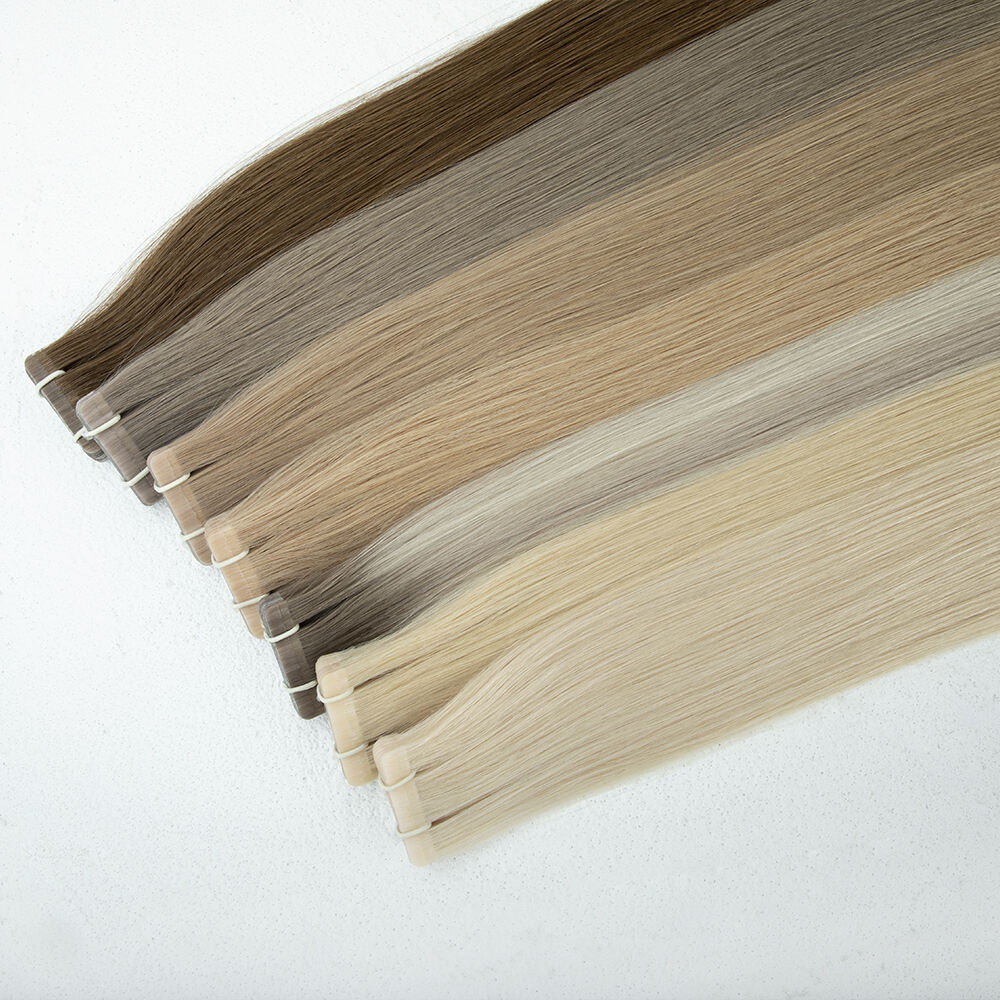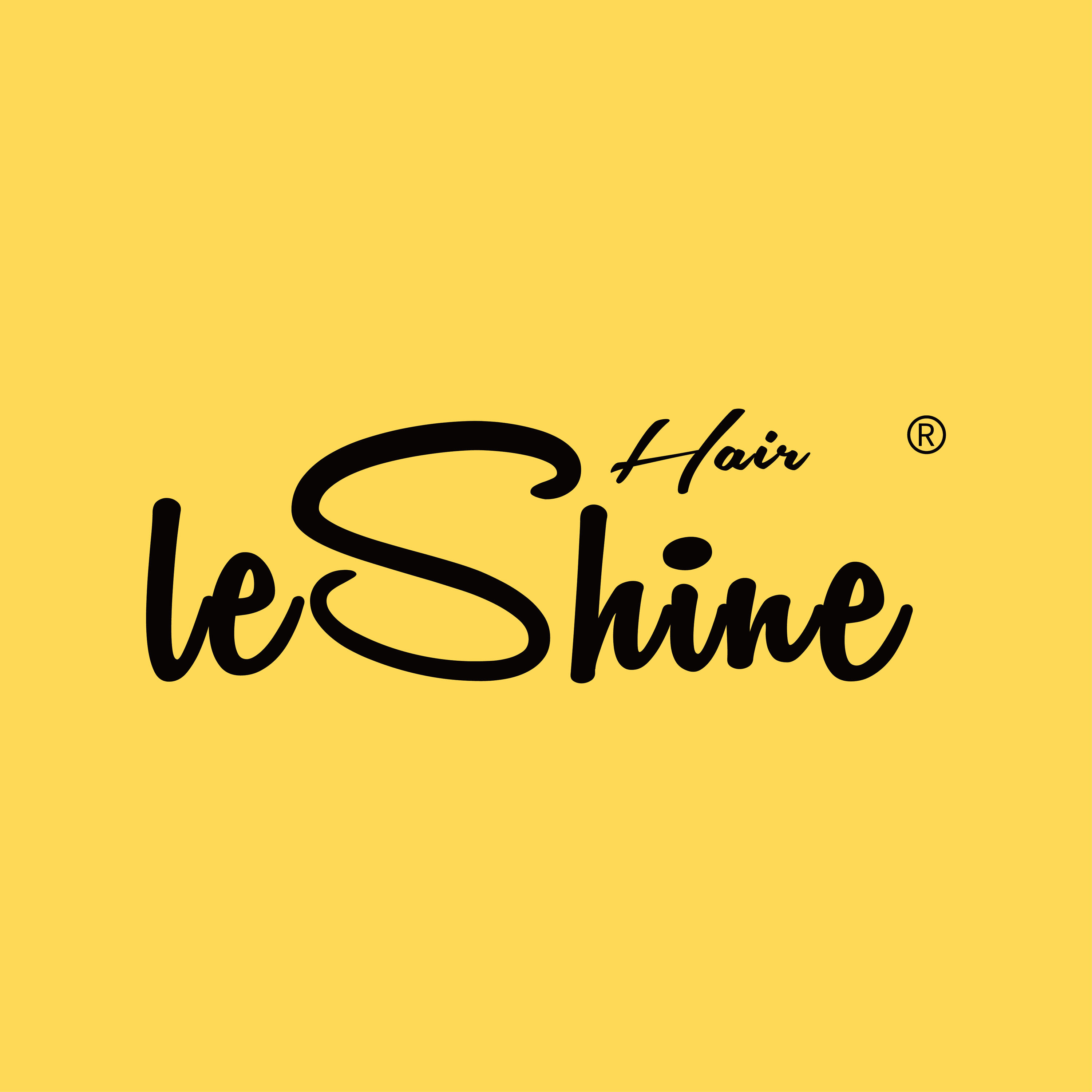
What Are Tape-In Hair Extensions and How Do They Work?
Understanding the structure of tape hair extensions
Tape hair extensions consist of 1.5"–2" wide wefts with medical-grade adhesive strips on one side. Each weft contains 50–80 strands of human or synthetic hair, tapered to mimic natural growth patterns. Unlike clip-ins or fusion methods, tape-ins use heat-free bonding that eliminates thermal damage risks.
How do tape-in hair extensions work for seamless blending?
A licensed stylist sandwiches 0.5cm sections of natural hair between two pre-taped wefts. This "sandwich" method:
- Distributes weight evenly (0.8g–1.2g per weft)
- Lies flat against the scalp at a <15° angle
- Matches the client's hair density within ±5% variance
Properly applied extensions maintain natural movement while resisting visible gaps—94% of users report undetectable blending in tape hair extension application studies (Ponemon 2025).
The science behind adhesive bonding and scalp compatibility
The polyurethane-based adhesive activates at body temperature (37°C/98.6°F), creating a flexible bond that withstands 4–6 weeks of wear. Clinical trials show:
| Factor | Tape-In Adhesive | Fusion Bonds |
|---|---|---|
| Tension Force | 12–15N | 18–22N |
| Hair Breakage Rate | 0.3% | 1.8% |
| Reusability Cycles | 3–5x | 1x |
This gentler grip reduces scalp irritation by 73% compared to microbead methods (Trichological Society 2025), making tape hair extensions compatible with sensitive skin types.
Benefits of Tape Hair Extensions for Natural Hair Health
Gentle, Heat-Free Application Protects Natural Hair Integrity
Tape in hair extensions take the heat out of the whole application process, which helps protect those important structural proteins and keeps natural hair properly moisturized. Fusion methods and clip ins usually need pretty high temps to work, but tape ins stick using pressure sensitive adhesive that doesn't mess with the hair's overall structure. Research indicates that going heat free can cut down on protein loss by around 34 percent when compared to methods that rely on heat according to some studies from the Hair Health Institute back in 2023. For people with thin hair strands or hair that's been through chemical treatments, tape ins tend to be much better suited since they don't add extra stress to already weakened hair fibers.
Reduced Strain on Hair Follicles Compared to Other Methods
The adhesive distributes weight evenly across panels, reducing focal tension on follicles. A 2024 hair extension safety study found tape-ins exert 63% less force per square inch than traditional micro-bead extensions. This translates to less hair loss during wear cycles and minimizes root irritation common with heavier attachment systems.
Lower Risk of Traction Alopecia With Proper Tape-In Placement
Tape extensions work best when a certified stylist puts them in, since they know how to follow the way hair naturally grows so there's no weird pulling from one direction. Leaving enough space between each tape strip helps keep pressure off the hair follicles, which is super important for preventing that hair loss condition called traction alopecia. Studies have found that when professionals handle the installation, people experience about 89% less breakage from tension issues than those who try doing it themselves at home according to research published last year in Trichology Journal.
Addressing the Myth: High Demand Doesn’t Mean High Damage
The popularity of tape hair extensions stems from their protective design, not inherent risks. Over 92% of users report unchanged or improved natural hair condition after 6 months of use when following maintenance protocols. Modern adhesives have evolved to mimic scalp pH levels, ensuring compatibility while maintaining adhesion strength.
Professional Application and Safe Removal of Tape Hair Extensions
Why Professional Installation Ensures Balanced Weight and Comfort
Trained professionals know exactly how to apply tape extensions properly. They use special medical quality glue and keep them about an inch away from the actual scalp area so there's no pulling or tugging on the hair follicles. According to studies done recently, around two thirds of all damage problems come from people trying this themselves at home without proper training, often putting the tapes right against their own roots. When done correctly, hair is divided into quarter inch sections running horizontally across the head. The extensions are then spread out over roughly between eighty and a hundred twenty little tabs throughout the hair. This helps distribute the weight better and prevents those annoying spots where hair tends to snap because of too much pressure concentrated in one area.
Step-by-Step Process for Secure and Invisible Tape-In Placement
Installation starts by sectioning off hair horizontally with a tail comb, then placing natural strands between two pieces of extension tape. Most stylists press down firmly for about half a minute to get those adhesives working properly so the extensions sit nicely against the head. What makes this technique work so well is how it blends in naturally. The ultra thin polyurethane backing basically disappears under regular hair when everything settles down. Clients rarely notice anything's different once their stylist finishes up.
Safe Removal Techniques to Prevent Breakage and Preserve Natural Hair
When removing hair extensions professionally, stylists typically use alcohol based solvents to break down those stubborn adhesives first. Then they gently slide the extensions down following the natural growth pattern of the hair. According to some research from 2023, going to a salon for this process actually cuts down on hair loss by about 83 percent when compared to trying it at home. That's because trained professionals know not to tug or pull which can really mess up the hair cuticles. The best part? After proper removal, there's no sticky residue left behind on the natural hair, so it stays healthy and ready for whatever styling comes next without any damage.
DIY vs. Salon: Evaluating Risks and Long-Term Outcomes
While DIY kits promise affordability, 92% require professional correction within three weeks due to uneven placement. Salon-applied tape-ins maintain secure adhesion for 6–8 weeks versus DIY’s 2.5-week average, proving more cost-effective while preventing long-term hair trauma from improper removal.
Daily Aftercare Tips to Extend Tape Extension Longevity
Wait 48 Hours Before Washing to Maximize Adhesive Bond Strength
Newly applied tape hair extensions require 48 hours for the medical-grade adhesive to fully cure. Avoid steam, swimming, and intense workouts during this period to prevent premature bond weakening. Sleeping on a silk pillowcase reduces friction that could disrupt the sealing process while keeping extensions tangle-free.
Wash Less Frequently to Preserve Tape Integrity and Alignment
Limit washing to 2–3 times weekly using lukewarm water and sulfate-free formulas. Massage shampoo downward from roots to ends without scrubbing the tape bonds. A 2024 industry analysis shows extensions washed 4+ times weekly lose 30% of their adhesion strength within 3 weeks compared to properly maintained sets.
Recommended Shampoos, Conditioners, and Styling Practices
- Cleansers: PH-balanced shampoos (4.5–5.5) maintain scalp health without dissolving adhesives
- Conditioners: Alcohol-free, lightweight formulas applied mid-lengths to ends
- Heat Tools: Always use thermal protectant sprays below 350°F to prevent bond degradation
Avoid Silicone and Oil-Based Products Near Roots to Prevent Slippage
Silicones create residue buildup between tapes and natural hair, while oils break down adhesive polymers. For refreshed roots between washes, apply cornstarch-based dry shampoos 2" below tapes using a makeup brush. This absorbs excess oil without compromising bond integrity.
Long-Term Maintenance and Re-Taping Schedule for Tape Hair Extensions
How long do tape-ins last? Typical wear cycle of 6–8 weeks
With good maintenance, tape hair extensions usually stay bonded for around six to eight weeks, which works well with how fast most people's hair grows naturally. According to research from the Hair Science Institute in 2023, about 8 out of 10 users kept their extensions firmly attached during this period as long as they followed basic aftercare instructions. The timing helps reduce stress on the scalp since it allows for roughly half an inch to an inch of new hair growth each month before needing reapplication. Most stylists recommend scheduling touch-ups right around when natural shedding occurs anyway.
Maintenance routines between re-taping appointments
Daily brushing with a soft-bristle tool (starting from ends upward) prevents matting near tape tabs. Sulfate-free shampoos preserve adhesive chemistry, with 73% of stylists in a 2024 industry survey recommending washing ≤2 times weekly. Nightly braiding or silk pillowcases reduce friction-related shedding by 40% compared to cotton alternatives.
Preventing damage during brushing, sleeping, and heat styling
Limit heat tools to ≤300°F and apply thermal protectant 2 inches from tape bonds. Microfiber towels pat-dry extensions instead of rubbing, decreasing surface wear by 29%. Avoid oil-based serums within 1 inch of roots—their lipid content degrades adhesive polymers 3x faster according to trichology lab tests.
Re-taping vs. full replacement: When to refresh your set
Re-tape every 6–8 weeks using salon-grade adhesives to reposition extensions closer to roots. Most sets withstand 3–4 re-tapings before needing replacement—typically when hair quality declines or 30% of tapes show reduced grip. Replace fully if ends fray beyond 0.5 inches or color fading exceeds 15% vibrancy loss.
Frequently Asked Questions
How often should I wash my tape-in hair extensions?
It's recommended to wash tape-in extensions 2–3 times weekly using lukewarm water and sulfate-free formulas to maintain bond strength.
Can I remove tape-in extensions at home?
It's advisable to have a professional remove tape-in extensions to prevent damage to natural hair. Professionals use solvents to safely break down adhesives.
How long can I wear tape-in extensions before needing re-taping?
With proper care, tape-in hair extensions typically last between 6–8 weeks before needing re-taping or repositioning close to the roots.
What are the key benefits of choosing tape-in extensions over other types?
Tape-in extensions offer a heat-free application process, reducing damage and tension on natural hair. They are also reusable and provide a more seamless blend with natural hair.
What should I avoid using on my tape-in extensions to extend their longevity?
Avoid using silicone and oil-based products near the roots, and always use a thermal protectant when heat styling
Table of Contents
- What Are Tape-In Hair Extensions and How Do They Work?
- Benefits of Tape Hair Extensions for Natural Hair Health
- Professional Application and Safe Removal of Tape Hair Extensions
- Daily Aftercare Tips to Extend Tape Extension Longevity
- Long-Term Maintenance and Re-Taping Schedule for Tape Hair Extensions
-
Frequently Asked Questions
- How often should I wash my tape-in hair extensions?
- Can I remove tape-in extensions at home?
- How long can I wear tape-in extensions before needing re-taping?
- What are the key benefits of choosing tape-in extensions over other types?
- What should I avoid using on my tape-in extensions to extend their longevity?




